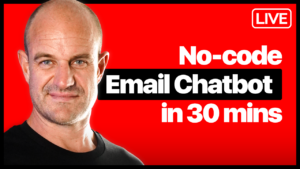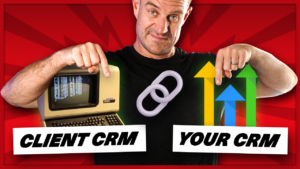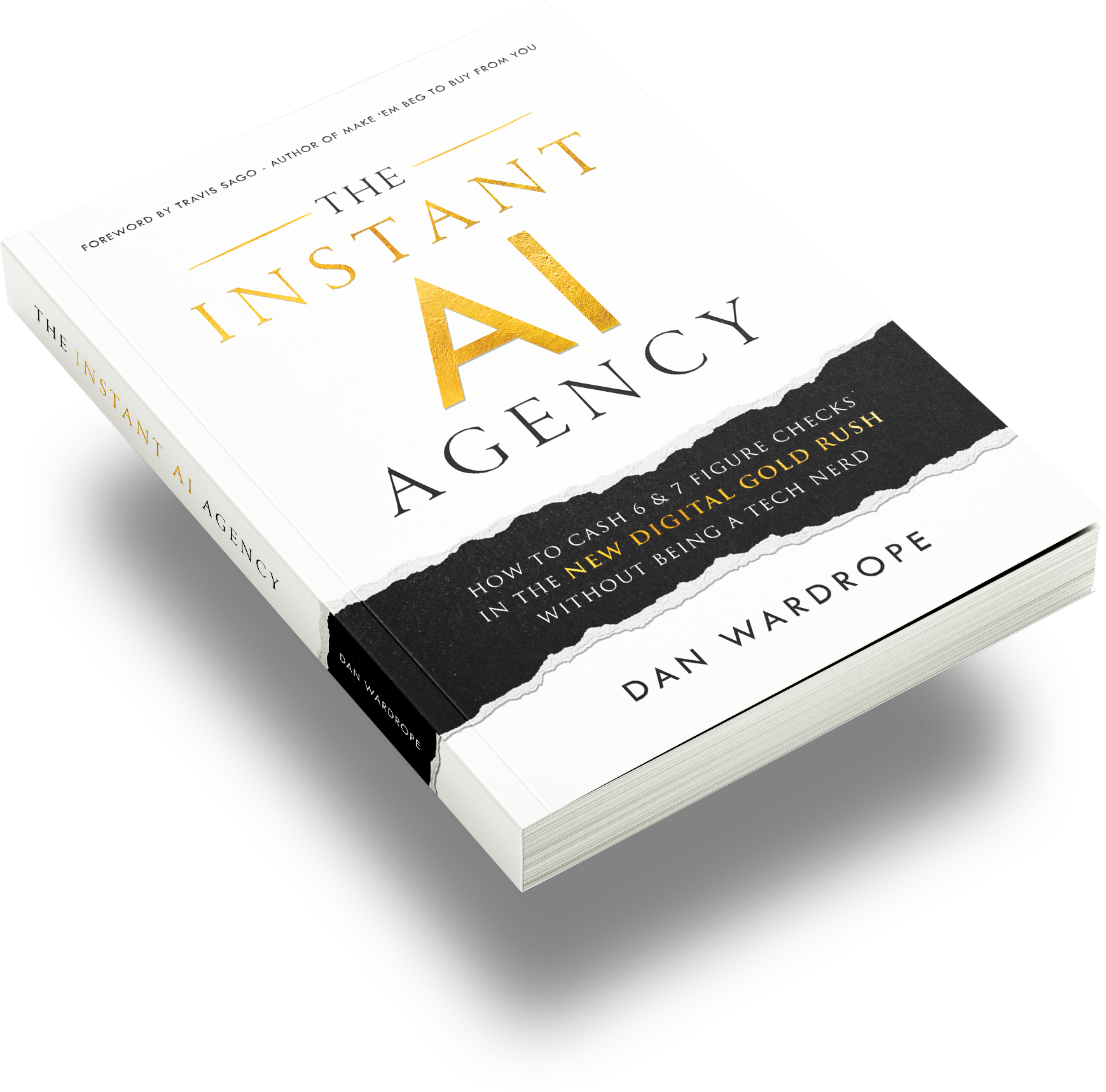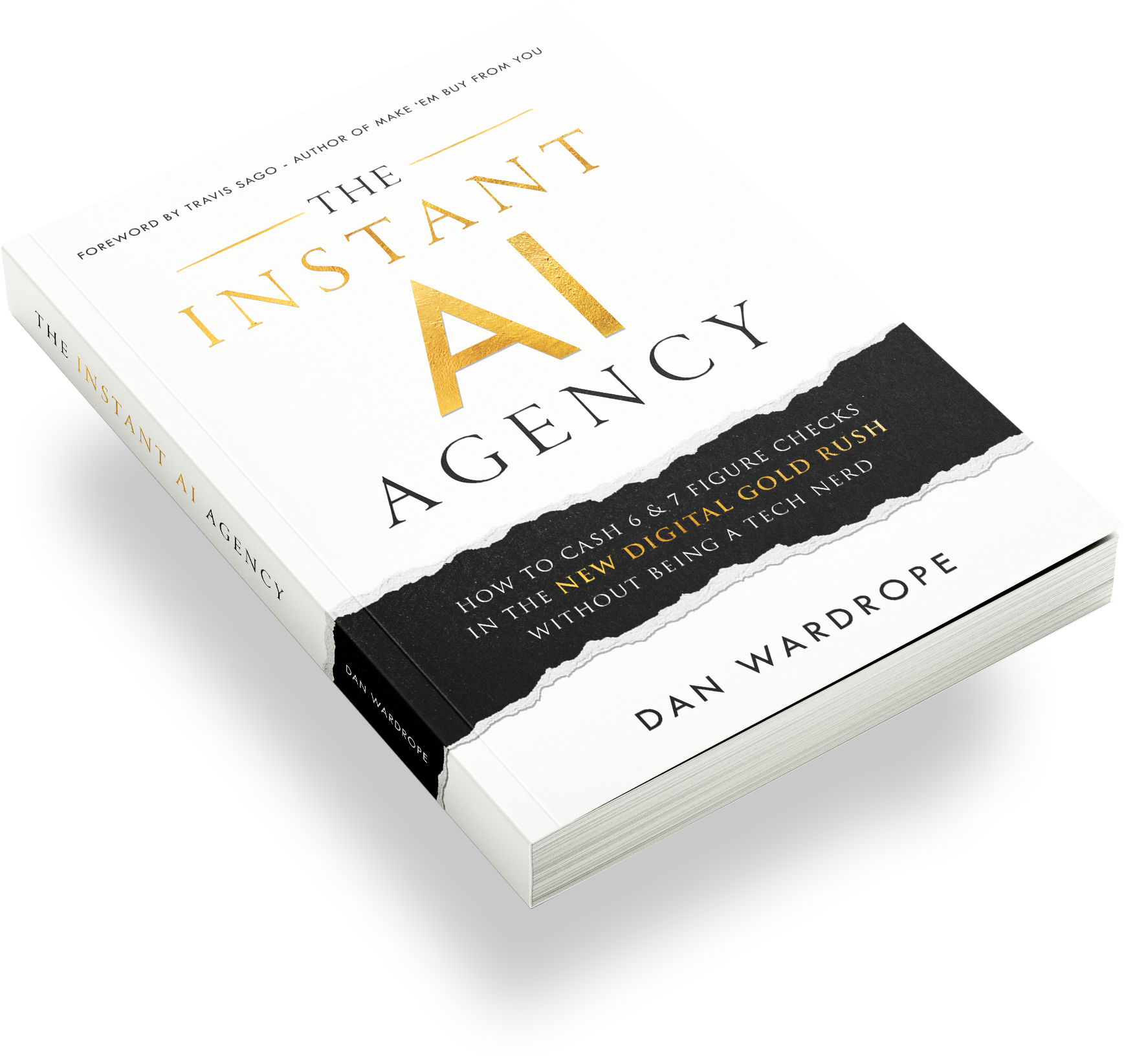Way back when I first started marketing, my target customer was a grey, shapeless mass of consumerism that would buy whatever I was selling for no other reason than the fact I was selling it.
There was a 67% chance they were female.
I knew they were about 30 or 40ish.
I also guessed that they lived in a big city in England, somewhere. Probably.
And I didn’t care a dab what their thoughts or feelings were unless said thought or feeling was: “I think I want to buy this product”.
So, from this vibrant and complex thought process, I managed to write a string of okay-ish ads. And, as you’d expect, these ads performed with the same okay nature in which they were born.
It wasn’t that my ads were horrible. I was getting enough leads. It was just that my ads were like taking a bite of frozen yoghurt when your mother’s told you it’s ice cream. Something was missing, and the whole experience was a disappointment.
Problem was, I knew my target customer existed but, beyond that point, I was pretty clueless. I had no idea about their motivation, or why they’d be interested in my product, or what made them tick.
To write ads that were going to appeal to my target audience, I had to pull up my sleeves, snap on some gloves, and dive into their heads. This meant creating a customer avatar and empathy map.
What Is A Customer Avatar?
Customer avatars are specific. Very specific.
Not just a list of demographics, a customer avatar is like mapping out a character for your new fiction novel. What do they look like? Who or what do they wake up to? How do they react in a crisis? Are they a cereal person or more of a toast guy?
Here are some points to think about when creating a customer avatar:
Gender
You may think your product or service appeals to both genders, but chances are one gender becomes a paying customer more than the other. If that’s the case you may want to look at the way you write your ads.
Studies on male and female linguistics show that people with a “male” brain speak the language of status and independence, while people with a “female” brain talk about connection and intimacy. Of course, there are always exceptions, but you may be surprised how tweaks in your language use can bring you closer to your ideal customer.
Studies have shown that certain words or phrases crop up more in female linguistic patterns and written work aimed for a female audience than in a male’s.
In her book, Language and Woman’s Place, linguistic professor Robin Lakoff claimed that the language used by women usually has more of the following:
- Hedges – phrases like “I mean”, “I think”, “sort of”, “kind of” and “as far as I can tell”
- So-called “empty” adjectives, such as “cute”, “divine” and “lovely”
- Precise colour terms, like “magenta” or “duck egg”
- Intensifiers, such as “so”, “just”, “very” and “really”
- Apologetic language
- Tag questions, like “isn’t it?”, “aren’t you?” and “don’t you agree?”
It’s also been found that 50% of women say that “beautiful” or “empathetic” or “descriptive” words play a key role in their purchase decisions.
Age
“Appeals to all ages” isn’t good enough. Find the age bracket for your avatar that most of your customers belong in (e.g. 25-45), then narrow it down to the ideal age of your ideal customer.
Remember, some products or services may be for a particular age group, but they aren’t purchased by that age group. For example, you’d advertise Year 6 SATs tuition to the parents, not the 11-year-old child.
Location
Even if your product/service has a national or worldwide appeal, writing ads that target particular regions will make your campaigns more successful.
In a 2015 IAB UK study, 46% of people said they use ad blockers as ads are “often irrelevant”. Location plays a crucial role in relevancy. Say, for example, that someone was looking to buy double-glazing. They see an ad, click, then see the company is based 200 miles away. Even if the double-glazing company offers a great price and a 100% satisfaction guarantee, the ad is still “irrelevant” to the user.
Targeting a specific area can also work for services like life insurance, debt consolidation and mortgages. Various studies show that personalised ads have increased engagement, and location-based personalisation plays its part.
For a car insurance ad, for example, your headline could read: “Millions of people are astounded by these plummeting car insurance rates.”
That’s okay. It’s nothing no one’s seen before, but it’ll get you a few clicks. However, try this for size: “Millions of Londoners are astounded by these plummeting car insurance rates”.
What seemed like a blanket offer before has now caused some ears to prick up. People looking for car insurance in London will think the ad is tailored just for them – personalisation. You can run exactly the same ad over and over, but swap the location and statistics to match your audience.
Income

It’s no secret that Facebook discontinued income level and net worth targeting in September 2018. Hugely popular with advertisers, this ban came as a crushing blow.
However, in February 2019, Facebook introduced Household Income By US ZIP Code. The new ad feature allows marketers to direct ads to people within specific income brackets. These brackets aren’t determined by a figure, but by percentage. For example, you could target the top 5%, 10%, 10-25% or 25-50% of US ZIP codes.
How much money your ideal customer makes will influence their buying decisions. Even if you’re not advertising to the US market, you still need to think about income.
Would low earnings prevent your ideal customer from buying your product? Is it something worth whacking out the credit card for? Without stating that you’re looking for customers with a certain income, how can you use your ad copy and images to appeal to the right kind of market?
Education
There are plenty of exceptions, but higher education often leads to a higher income.
Understanding someone’s education level will also help you communicate effectively. Will they be enticed by blocks of text, or would they prefer lots of images? Would they appreciate statistics and graphs? Do they want a long description or just a few bullet points? Does a complicated idea need to sound very simple to generate sales?
Simple is usually best. If you need to explain what your ad means, or someone needs an IQ of 140 to figure it out, your ads have failed.
Occupation
Occupation usually tells you something about the ideal customer’s income level and, therefore, their education (but not always!). Does your ideal customer have a stressful job? Are they constantly busy? Is your product or service a bit of a “magic pill” that will make their lives easier? Would a dentist be interested in a Wednesday afternoon creative writing course? Would a nursery school teacher want a package holiday to Ibiza? (probably). These are all things to think about.
Interests
And, by interests, I mean everything. What TV does your ideal customer watch? What time are their favourite programmes? Books or magazines? Do they have a favourite clothing brand? Are they outdoorsy types or do they have Netflix AND Amazon Video subscriptions? What do they do on weekends? Do they like travelling? Can they afford to travel?
The deeper you go into your ideal customer’s interests, the more you’ll understand them as a person. It doesn’t matter if them liking Coronation Street has nothing to do with you selling life insurance. How can you use their interest in Coronation Street to your advantage?
If you’re making references that strongly resonate with your customers, then they’re more likely to trust you. Your voice is that of a friend, rather than a salesman. Trust = more leads = more sales.
Online Behaviours
If you’re going to write some wonderful ads, you’ve got to make sure your ideal customer will see them. So, question yourself: how does your No. 1 customer consume content?
Do they sit on the loo reading emails or barely look at their phone? In 2018, 95% of 16-24 and 25-34 year-olds owned a smartphone in the UK. For older adults (55-64 year-olds), this percentage drops down to 51%.
However, with those who do own a smartphone, 92% admitted to using theirs on the toilet (Buzzfeed News). Why is this important? Because it proves that a lot of people look at their smart times multiple times a day, every day.
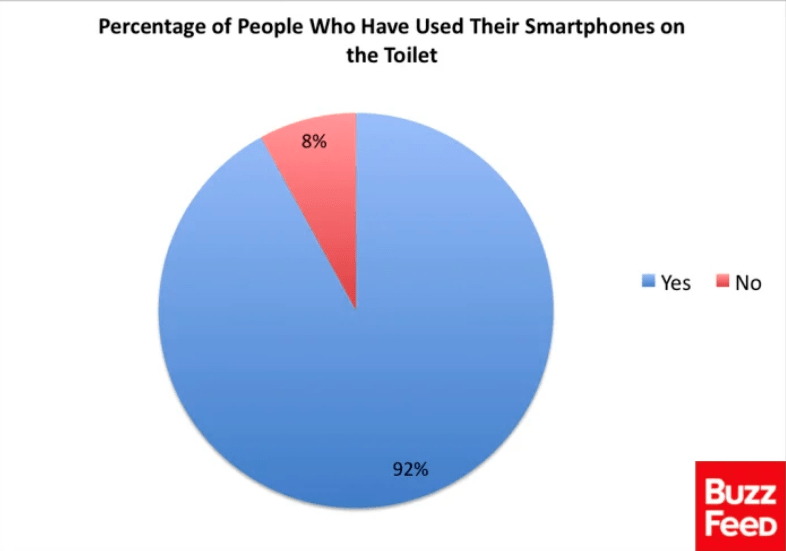
Off the back of that, what social networks does your ideal customer use the most?
Facebook is a pretty safe bet. 68% of adults use Facebook, with the most prominent users being 13-17 (88%) and 18-29 (84%).
Other age groups are active users too. 72% of 30-49-year-olds are on Facebook, along with 62% of 50-64-year-olds and 62% of 65s+.
Here are some other, quick, social media platform figures:
- Instagram is the most popular with 13-17 year-olds (72% are active users), dropping slightly for 18-29 year-olds (64%). Only 10% of 65s+ use Instagram.
- 40% of 18-29 year-olds use Twitter. 24% of the female online population has a Twitter account, alongside 23% of online men.
- 31% of the online female population have a Snapchat account, in comparison to 23% of online men. Again, Snapchat is the most popular with 13-17-year-olds (69%) and 18-29-year-olds (68%). Only 26% of 30-49 year-olds have Snapchat.
The idea is to place your ads where your ideal customer is going to see them.
Goals
To write the perfect avatar, you need to understand what drives your customers. What gets them out of bed in the morning? Do they have a specific dream that overrides all others? What’s their idea of a perfect day?
You don’t have to agree with these hopes and dreams, but it’ll help you see the customer has a person rather than a ream of data. How can you tap into these aspirations to help you sell your product/service? If they already have the best kind of life, how will your product make it even better?
Pain Points and Struggles
Even if someone has the BEST LIFE EVER, they’re still going to deal with little quibbles throughout the day.
Ask yourself:
- What keeps them up at night?
- What are their top 3 daily frustrations?
- What’s the worst that can happen if things stay the way they are?
However serious the problem, it’s your job to present the solution. Use your ad to tap into their pain points, then present your product as the only possible answer to their issues. Remember, seeking to soothe pain can be an enormous motivation to buy!
Shopping Habits
What other products or services does your ideal customer buy? Have they purchased something similar to your product/service before? Why didn’t it work out for them? Are they internet shoppers, or would they prefer to go to the store? If the latter, how will you persuade them to buy from the internet? Do they shop for food every day, or have one big shop at the weekend?
What do their favourite brands say about them? Do your brand values roughly match that of the preferred brands? Is there something that all the brands have in common – i.e. expensive or cheap? How do the customer’s preferred brands “speak” in adverts? Can you mimic the tone, or do you have something new to bring to the table?
With all this information, you’ll now find you’re addressing “someone” rather than “everyone” (read: “no one”). At this point, you should have ended up with something that looks like this:
![]()
This is just a quick example, and yours will contain lots more detail.
So, you now know what a customer avatar is. How to do you begin to make one?
How To Build A Customer Avatar
Before you start with names, ages and genders, you have to do some market research.
The best place to start is with your client. Get them on the phone or schedule a Skype call. Make sure you ask for at least 30 minutes of their time. Your client should be able to answer all your questions based on stats from their CRM system.
Other than the customer, your client is best going to know the benefits of their product/service. Ask them questions like:
- What are the features of your product/service?
- What are the benefits?
- How is your product/service different to others in the market?
- Why are your benefits believable?
- What benefits are the strongest and most appealing?
- Can you direct me to your top 5 customer testimonials?
- Tell me your ideal customer’s demographics – age, gender, marital status, income, occupation, etc.
- What are their possible objections?
- What are their goals?
And so on.
Even better, compile a list of questions and email them to your client. This way, you’ll get your response in a written format. Make sure you store the document somewhere safe!
Check Out The Competition
The easiest (and sneakiest) way to get to know your customer is to check out competitors’ websites. This way, you’ll be able to analyse the strengths and weaknesses of your competition, “swiping” good ideas when necessary and always aiming to do one better.
Do a quick Google search to identify your current competition. Your main competitors will be the first on the page.
- What sort of language do they use? Is it off-putting or straightforward?
- Do they have any images? How do they make you feel?
- Is the information easy to find?
- Do they have any testimonials? What do the customers like best about the product/service?
- Do they provide any downloadable “guides” on the website?
- Does the competition always strive to “add value”?
Note down what you like and don’t like about the websites. If the competition has testimonials, note down the names and ages of the customers (if available). What kind of language does the customer use? That can give you some tremendous insights into gender, age and education.
Most testimonials will also supply the customer’s specific pain point, which your competitor was able to solve. Note down the pain points, even if it’s something inconsequential as “they were non-judgemental” (i.e. implies a fear of being judged).
Go Onto Trustpilot
Another great place for customer reviews is Trustpilot. Remember, your competition will only show glowing reviews on their website!
Find your top competitor’s website address and put it in the search bar. You’ll be able to scroll through several reviews and work out the competition’s main strengths and weaknesses.
Search For Facebook Fan Pages
If people are interested, passionate or worried about something, they’ll likely be part of a Facebook group or page.
Start by typing your niche within the search bar. This can be something as simple as “debt” or “healthy eating”.
From the top bar, select “pages”. You’ll get a list of fan pages starting from the most popular all the way down to those with only one or two likes.
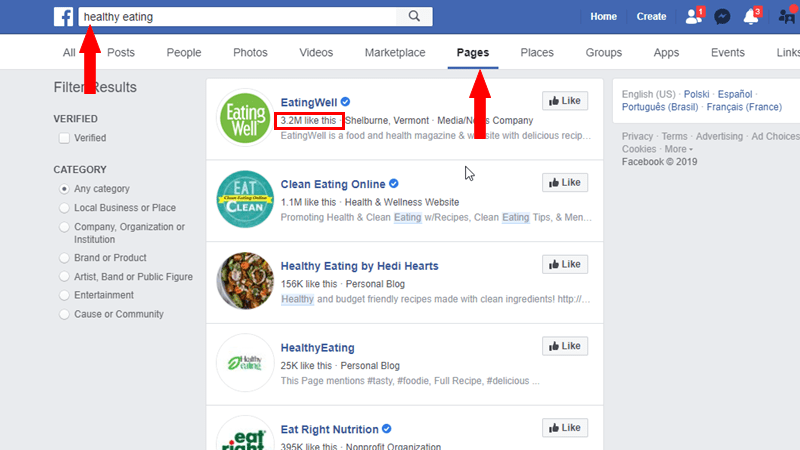
The more popular the page, the more interactions on its posts. Select the most popular page to start with.
Once you’re on the page, head down to Posts:
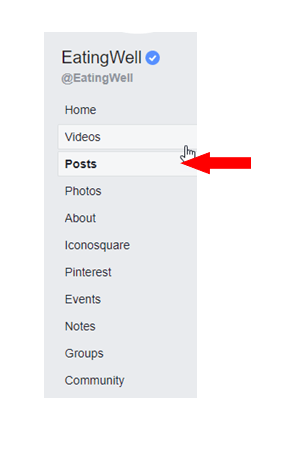
You’ll quickly see that EatingWell’s fans care about healthy new recipes, articles on nutrition and high-quality pictures of delicious-looking food.
Select a popular post from the page and take a look at the comments:
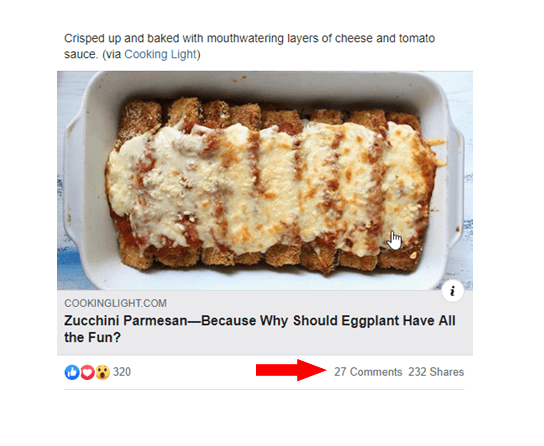
Facebook comments are interesting because they often don’t contain too much thought. Unlike a testimonial or review, where the happy or unhappy customer has to think about what pleased them/upset them, a Facebook comment has much more of a “snap reaction”.
You can gauge a lot about your target audience from the comments. Who’s commenting more often? Men or women? Roughly how old are the commenters? Where do they come from?
Read as many posts and comments from as many pages within your niche as you can. Note down any correlations.
Then go further.
Find the most popular page roughly within your niche, and select “Community” from the left-hand side:
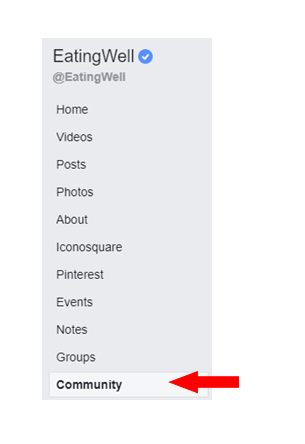
In “Community”, you’ll find posts from fans with their own ideas and contributions for the page. Again, this is a great place to see interactions from people interested in the same areas.
There also may be questions directed at the page admins. If the user is looking for advice, take note of what they’re asking. It could help you identify their pain points later on.
Finally, use Facebook to see what ads the pages are currently running.
Though you won’t be able to see any stats about the ads (demographics targeted, likes, comments), it’s still a great way to see what ads your competition is putting out there.
Take note of the language used, the headlines and the images.
To see the ads, scroll down the page until you see this box on the right-hand side:
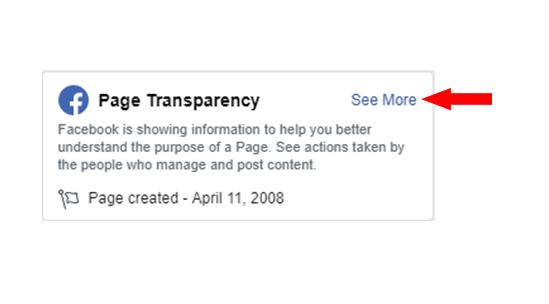
Click “See More”.
A new box will pop up, listing the page history, the people who manage the page, and whether the page runs any ads.
Click “View In Ad Library” in the “Ads From This Page” section.
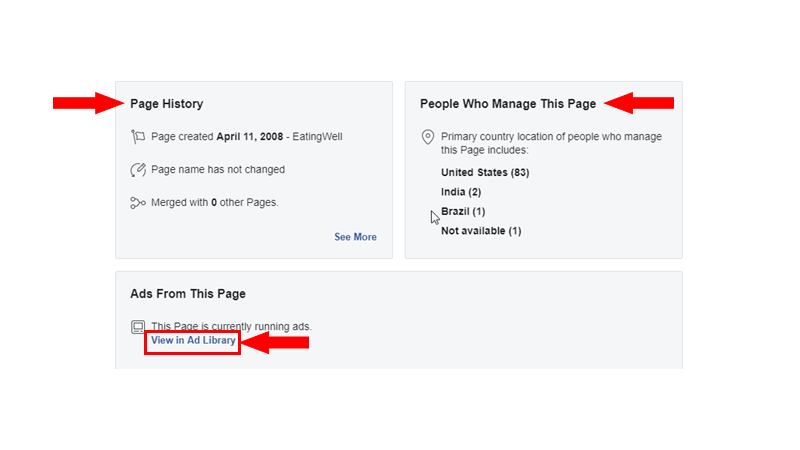
Near the top of the page, you’ll see a small box that says “Filter By”. If you’ve got any options, select what country you’d like from the drop list.
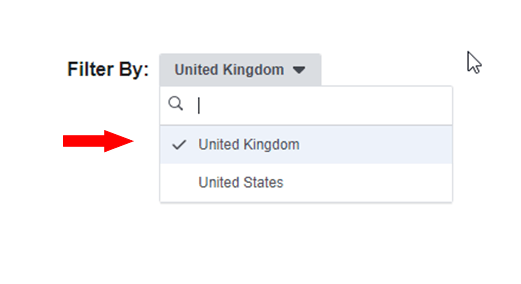
There, you’ll be able to see all active ads currently running from the page. They’ll all be in month order, and you can see the day they became active.
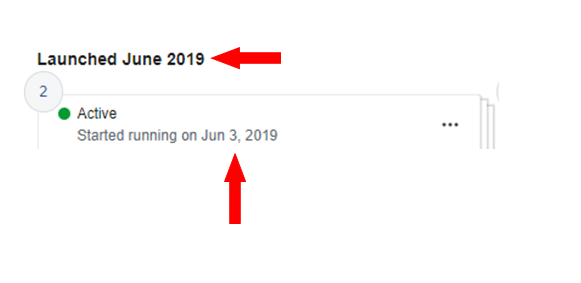
Underneath each advert, you’ll be able to see “See Ad Details”. Unfortunately, Facebook doesn’t tell you any stats about the ad or let you see any comments and reactions.
Still, you’ll be able to check out the copy and the images they’ve used, as well as see the page’s variations of the ad.

If it’s a popular page, chances are the admins produce successful ads. Jot down a list of what you think works, and file it away for future use.
Join Facebook Groups
Another great way to get a sense of your audience is to join a Facebook group.
Note that some Facebook groups are going to be “closed”. You can still view the name, description and members list of a closed group, but you won’t be able to see any posts until you’ve been accepted by an administrator. These groups may require you to answer a few questions before you join.
However, there are plenty of groups that’ll let you see discussions and posts with a simple “click to join” process.
You’ll notice that a lot of these groups ban advertising:
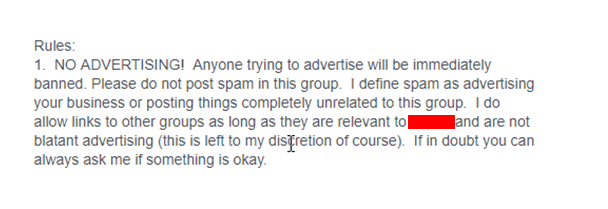
This shouldn’t be a setback.
Free from advertising and businesses “pushing their agendas”, members are asking questions they usually feel they couldn’t ask.
If somebody has a problem they want to solve, they need to trust you and your content before you can help them. As many members within a private group are or were in the same boat, users are more likely to trust advice from someone who’s “lived it” rather than help from a faceless corporation.
Pick up a pen and jot some notes on the following:
- What kind of questions do members ask?
- How much do the commenters know about the field?
- Are members looking for practical advice or sympathy?
- Are commenters discouraged from recommending specific companies? If so, why?
- Do comments often link to outside articles?
- Do members prefer expert advice, or are they willing to accept help from hobbyists?
- Are there any frequent objections with the advice given?
- Do members often ask for resources?
Once you’ve got some notes, add them to your customer avatar draft. Your document should be pretty detailed by now.
Other Forums For Your Customer Avatar
You don’t have to stick to Facebook!
To learn more about your target audience, you need to research forums where the members are active.
Reddit is a great place to start, as it has tonnes of subreddits for niches and niches-within-niches.
Head over to reddit.com. In the search box, type in the niche you’re looking for. There, you’ll get a list of subreddits and threads to look through.
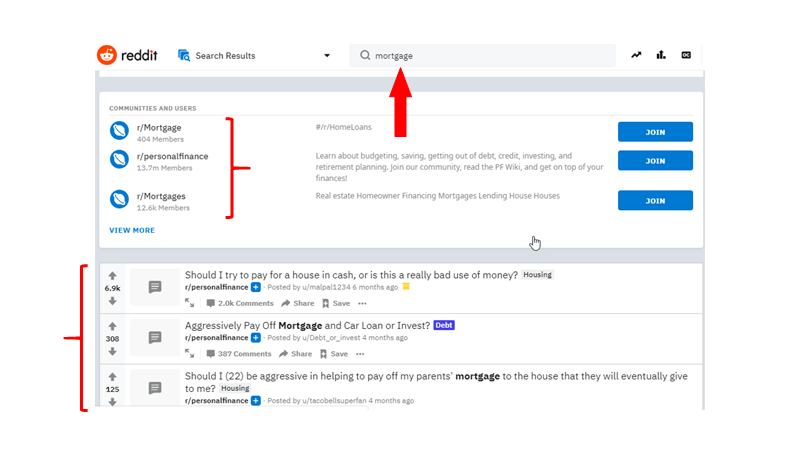
For the most popular threads in your niche, go to the filter at the top of the page and select “Top” and “All Time”.
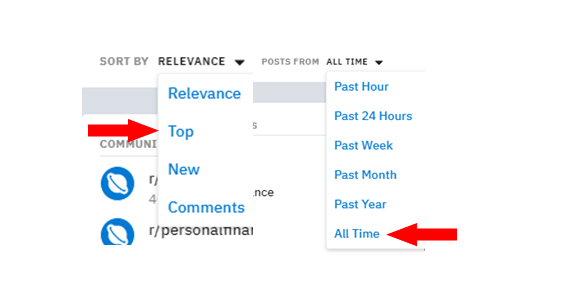
This should give you a good clue on what readers within the niche care about the most.
Go through as many threads as you can, asking the same questions as you did with the Facebook groups and fan pages.
If Reddit isn’t coming up with the goods, search Google for a forum instead. Just type in “[Your Niche] Forum”, and you should find several responses perfect for your research and avatar.
YouTube Ads
For every person who likes to read a long article, there will be another who learns via video.
Search a mixture of ads within your niche and instructional videos. Make a list of the pain points the video cover, along with questions answered and useful tips.
If the video received a lot of negative feedback, why? What was missing? Likewise, if a video has tonnes of positive comments, write down what the audience liked best.
If you think your niche will have few results on a video platform like YouTube, give it a search anyway.
Let’s take “mortgages” again. When I put “mortgages” into Youtube, the first result has 15,000 views.
The second has 389,000 views. The third has 114,000, and the fourth has 321,000.
See for yourself:

Even if YouTube wouldn’t be your go-to platform to research mortgages, the viewing figures prove that a percentage of your target audience use video as a helpful or instructional tool.
Paying attention to demand means you’ll be able to create relevant and compelling content later on.
Create a Survey
Now you’ve got the bones of a persona, it couldn’t hurt to test what you’ve found against some real, live customers.
Your client will have access to all the demographic stats you need. Ask your client if you could segment a part of their existing database and send customers a survey.
Make sure the survey isn’t too long (too many questions and you’ll get very few results), and ask a mixture of demographic and psychological questions. You can create a survey for free on SurveyMonkey.
Once you’ve got the results, it’s time to look at the answers in comparison to your own insights. Do your research and predictions match what you thought? If so – great! You have a good understanding of your client’s ideal customer.
If not, not to worry. You now have qualitative data from the client’s target audience, which you can use to reverse-engineer your avatar.
Empathy Maps
Now you’ve done your research, you should be able to assemble a pretty detailed customer avatar. Here’s a quick one again, just as a reminder:
![]()
Again, your customer avatar will be a lot more detailed than that.
Now, at this point, your ideal customer should be looking like a genuine person. You’ve got some seriously specific ideas about their demographic, psychographic and behavioural information.
But you can still go further. An empathy map will really help you get inside your ideal customer’s head.
What Is an Empathy Map?
An empathy map is a tool that lets you better understand your customer base. Like a customer avatar, an empathy map enables you to visualise your customer needs, wants, and deepest (secret) desires. Because it requires you to plant yourself in your ideal customer’s shoes, it’ll help you realise what consumers actually want – not what you think they want.
This is where boiling down to a niche within a niche gets really handy.
Let me give you an example.
Take the UK bookstores Waterstones and WH Smiths. Though both chains sell a wide variety of books in labelled sections, they are designed to please a different type of target customer.
An empathy map can tell you why some people prefer WH Smith to Waterstones (or vice versa), even if customers want the same outcome (i.e. getting a good book). Waterstones, for example, has a public library, “browse before you buy” feel. Most stores have books of all different genres as vibrant window displays. The lighting inside is bright, yet warm – perfect for reading. There are tables dotted around, groaning with classics to bestsellers. If you plan on staying a while, there are usually chairs in cosy corners. Waterstones are also famed for their “book recommendations” from the staff. A handwritten card provides the book’s genre, a single-line plot synopsis, and why the staff member liked it.

WH Smith is for book lovers who know what they want. With no literary pretences, WH Smith stacks books from the bestseller list ceiling-high. They usually have some sort of deal going on too – Buy One, Get One Free or £3 Off RRP. While a Waterstones loyalist may treasure bright-eyed assistants making recommendations and asking “can I help you?”, a WH Smith lover could find it off-putting. In fact, WH Smiths reportedly doesn’t employ “booksellers” because of extensive customer research (thebookseller.com). Surveyed customers felt that booksellers were more likely to judge their purchases negatively. WH Smith also has plenty of stores in small towns, unlike Waterstones who prefers more populated areas. For WH Smith, book buying is less of an “event”.
You’ll notice that these two book chains don’t differ much in what they offer, but how they pander to their target customer’s mindset. An empathy map will help you do the same for your product/service, so you can differentiate yourself from the competition.
What Do Empathy Maps Look Like?
Empathy maps are often divided into 6 sections, with the ideal customer as the centrepiece:
- Think and Feel
- Hears
- Says and Does
- Sees
- Pains
- Gains
Here’s a blank one I sketched out earlier:
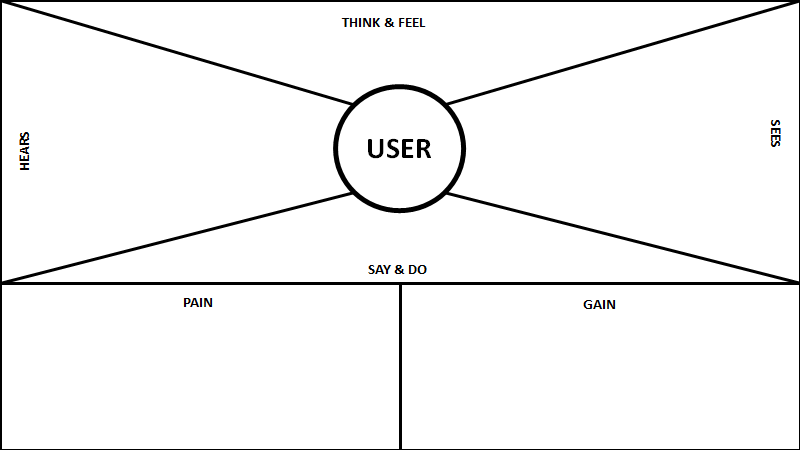
The idea is to fill in the blanks with as many thoughts as possible. You can do this on your own or as part of a team.
How To Create An Empathy Map
First things first, you need your customer avatar at hand. There’s no point in trying to put yourself in the shoes of your ideal customer if you have no idea who your customer is.
If you’re doing the empathy map as a team, draw one up on a whiteboard or flipchart. Give each of your team members a set of different coloured Post-it Notes.
The idea is to fill up the board with ideas. Each team member should come up with at least one or two ideas per section.
When a team member puts an insight onto the board, they should explain their thought process to their colleagues. Keep going around the group until each section has been completely filled up.
At the end of the empathy map session, each team member should voice the most important thing they’ve learned during the meeting.
Remember – if you want to do the empathy map as a group, make sure the members have seen your research, data, statistics and customer avatar.
Consider the Following Questions
Ask your team the following questions and let them think before they start adding answers to the board. A more structured approach means you’ll all have time to really think about your customer’s emotional needs, rather than just fire off ideas willy-nilly.
Think and Feel
- What keeps your target awake at night, indigestion boiling up their oesophagus, eyes open, staring at the ceiling?
- What are they angry about? Who are they angry at?
- What are their beliefs and dreams?
- What makes them sad and scared?
- Is there a built-in bias to the way they make their decisions? (example: engineers = exceptionally analytical)
Sees
- What sights surround the target’s home?
- What do they see at work?
- Who do they see the most? Friends or family?
- What trends do they see if their work, home and social life?
- What will the target think when they see [your product/service/advertisement]
Hears
- Who does your target customer hear from most often?
- What media are they influenced by?
- What would their boss/friends/family say if they knew the target used [your product/service/advertisement]?
Says and Does
- What are the target’s top 3 daily frustrations? How do they handle them?
- How does your target behave in different environments? I.e. in public, in private, with friends, family and co-workers?
- How do they speak to others? Do they open up more to friends or family?
- Do they have their own language?
- What would the target say and do while using [your product/service]? Would this change if other people knew the target used [your product/service]?
Pains
- What is your target most afraid of?
- What daily stresses do they encounter?
- What’s stopped them dealing with the problem before?
- Why have other [products/services] failed the target before?
Gains
- What do they secretly, ardently desire the most?
- What does the target need to reach their goals?
- How does the target measure success?
Think About These Questions Until You Reach A Final Draft
Whether alone or with a team, you will need at least two hours to get a detailed empathy map.
When it comes to your final draft, look for patterns in your answers. If several members of your team have similar ideas, condense them down to one focus point.
You don’t want an overstuffed empathy map, as it’ll cause confusion later on. If each segment has 30 ideas in it, choose the 10 most crucial points.
Once you’ve got 10-15 items in each segment of your empathy map, all which accurately reflect your customer avatar, you’re done!
Customer Avatars and Empathy Maps: Conclusion
If you want your ads to make a real impact, there’s nothing more important than understanding your ideal customer.
Create a customer avatar and empathy map whenever you take on a new client – even if they’re in the same niche. Chances are, their niche within that niche will be very different.
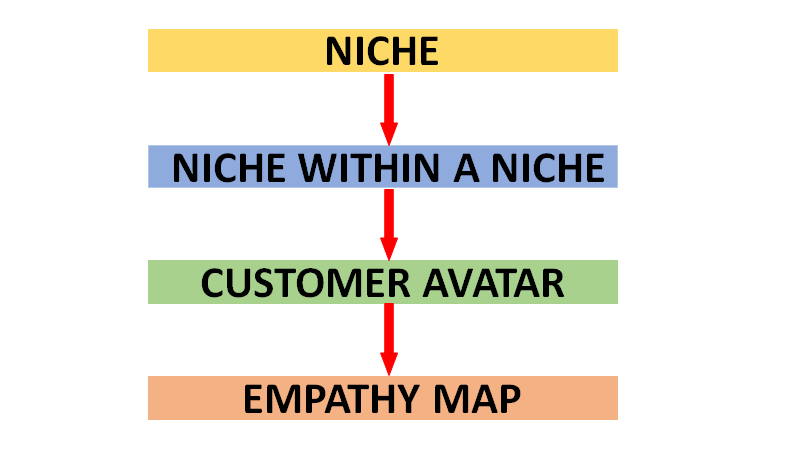
Remember, all buyers are multi-faceted human beings. Sometimes they’ll make buying decisions that go against all reason, even if you’ve done a lot of research. If that happens, try not to panic. Keep an eye out for any unusual patterns, or buying behaviours that go against your predictions. If something stands out, use the info to reverse-engineer your avatars and empathy maps as soon as possible.
Because, at the end of the day, the more you understand and pay attention to your customer, the better you’ll be able to market to them.
***


